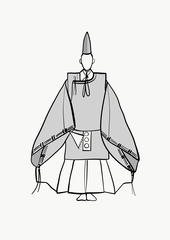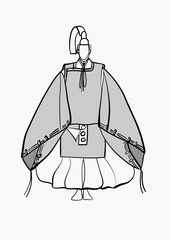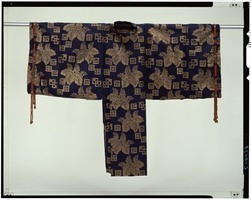Kariginu
かりぎぬ 狩衣
Noh Kyogen
Roles and Draping Styles
Despite the wide range of characters, both human and supernatural, that wear kariginu there is only one basic draping: the body lapels are bound at the waist so they hang loosely over the belt and the hem covers the top third of the wide divided skirts, which may be ōkuchi (ministers, notably waki roles in many first-category plays) or hangiri (supernatural beings, such as the Thunder God in Kamo 『加茂』 or the tengu in Kurama Tengu『鞍馬天狗』) or sashinuki 指貫 (courtiers, as in Unrin'in『雲林院』 and Tōru『融』). An alternative draping for warriors involves folding under the round collar and hiking up the sleeves.


Tailoring
A three-quarter length robe is distinguished by the round collar with overlapping narrow front panels and double-width sleeves open at the cuffs. The seams connecting the sleeves to the center panels are short and mostly at the back, so that the drape over the chest remains independent of the movement of the sleeves.The round collar (sometimes squared off) is a feature shared with court costumes that are based on ancient Chinese styles. Cords attached at the edge of the collar on the left overlapping front panel are used to fasten the collar to the right panel. Other cords are laced through narrow cloth strips along the edge of the sleeves. This reflects the origin of the garment as a 'hunting cloak' (kari=hunt, kinu=garment). When out on a hunt, the oversized sleeves could be bound at the wrist with these cords. In everyday life, kariginu were worn as informal wear by the Heian nobility and later as formal wear by the military aristocracy. The kariginu can either be lined (awase) or unlined (hitoe).
Textile Features
Most typically lined kariginu use a solid-ground weave such a satin or twill with gold or silver or colored silk thread supplementary patterning. When gold designs are set against a dark ground, it is common to use an extra yellow or red warp in a lampas weave to hold down the pattern threads so as not to dull their impact. Multi-colored supplementary patterning on twill or satin gives a more refined effect. Figured satin, double weave, and embroidery are alternative decorative techniques. Old kariginu are often made from imported fabrics (meibutsu gire) or imitations thereof.
Unlined kariginu are woven of thin, gossamer material. They are worn by elegant courtiers, young warrior courtiers who die in battle, and aged spirits of plants. The weaves include gold patterning on ribbed gauze weave (rokin), patterning with supplementary colored threads on plain gauze weave (sha) or self-patterned plain gauze weave (monsha). For a more rustic feel, monotone coarse plain weave with displaced wefts (yore) is also possible.
Designs and Colors
Lined kariginu worn by strong characters tend to have dark solid color grounds such as deep red, indigo blue, or green with large geometric patterns in gold or silver. For aristocratic characters, the ground color might be white or light yellow, or it might have multi-colored smaller repeat patterns. These can be geometric, like the Okina kariginu pattern of interlocking hexagons and squares, but might also be derived from nature, such as flower scrolls.
Unlined kariginu tend to be a gentler blue, green, cream, or white and have designs reminiscent of court patterns (yūsoku monyō). (MB)

Kariginu with paulownia and scattered squares on a dark blue ground. 18th c. Tokyo National Museum